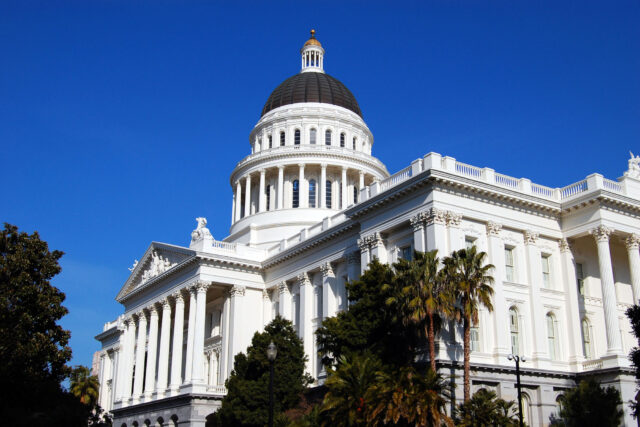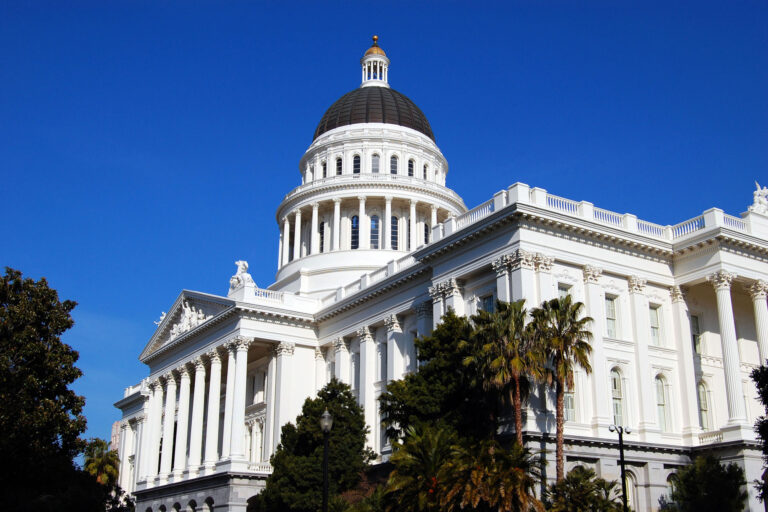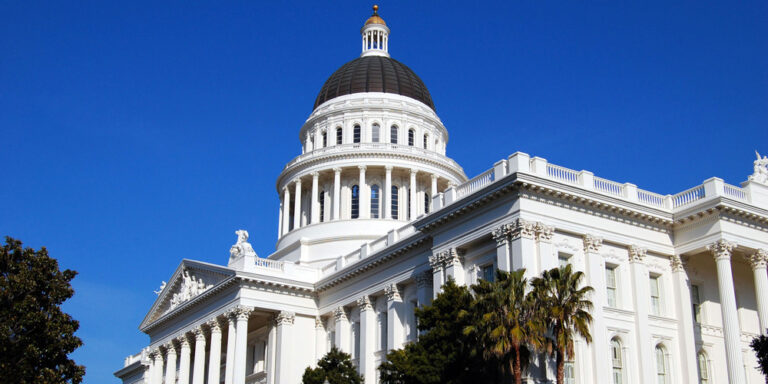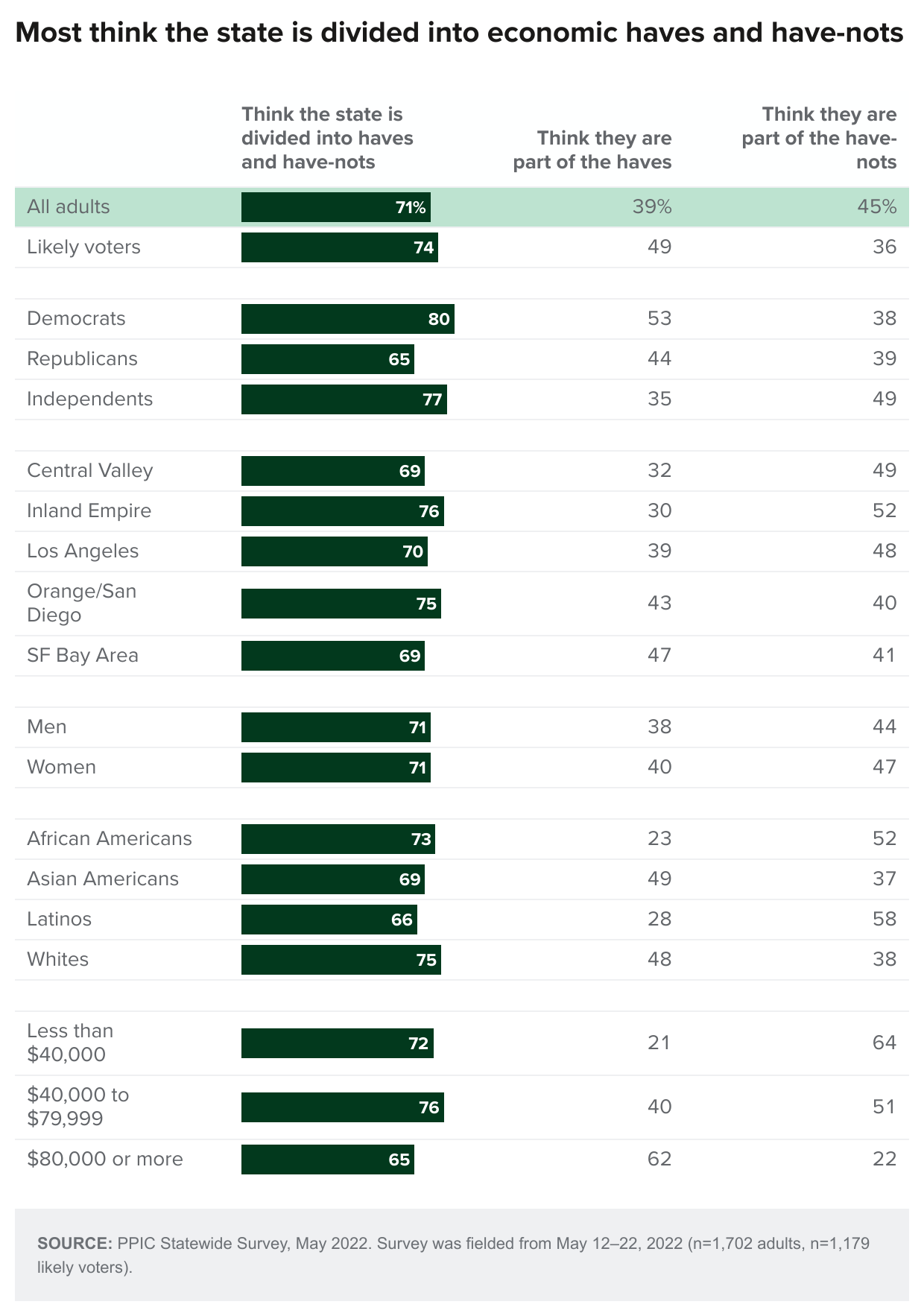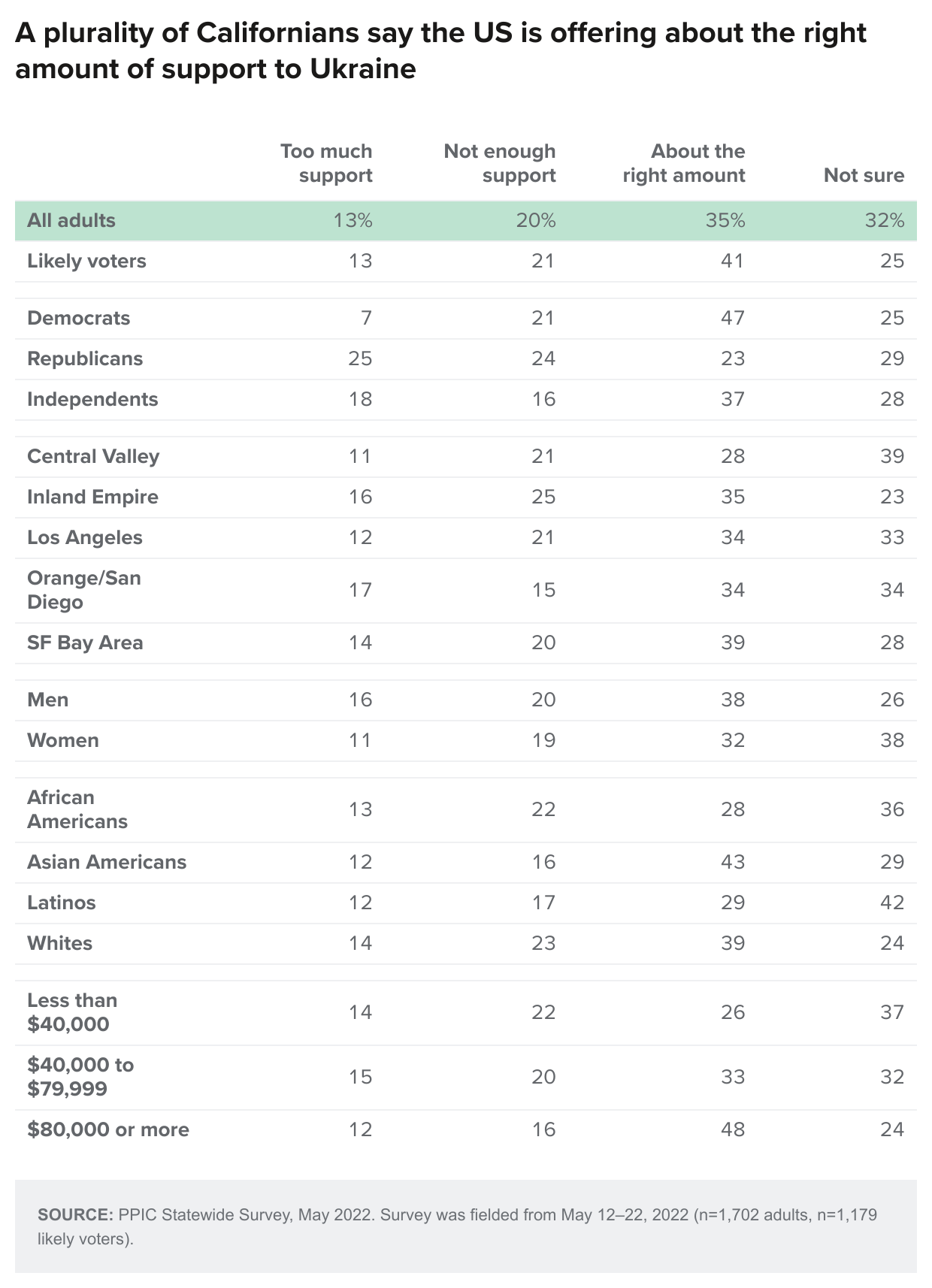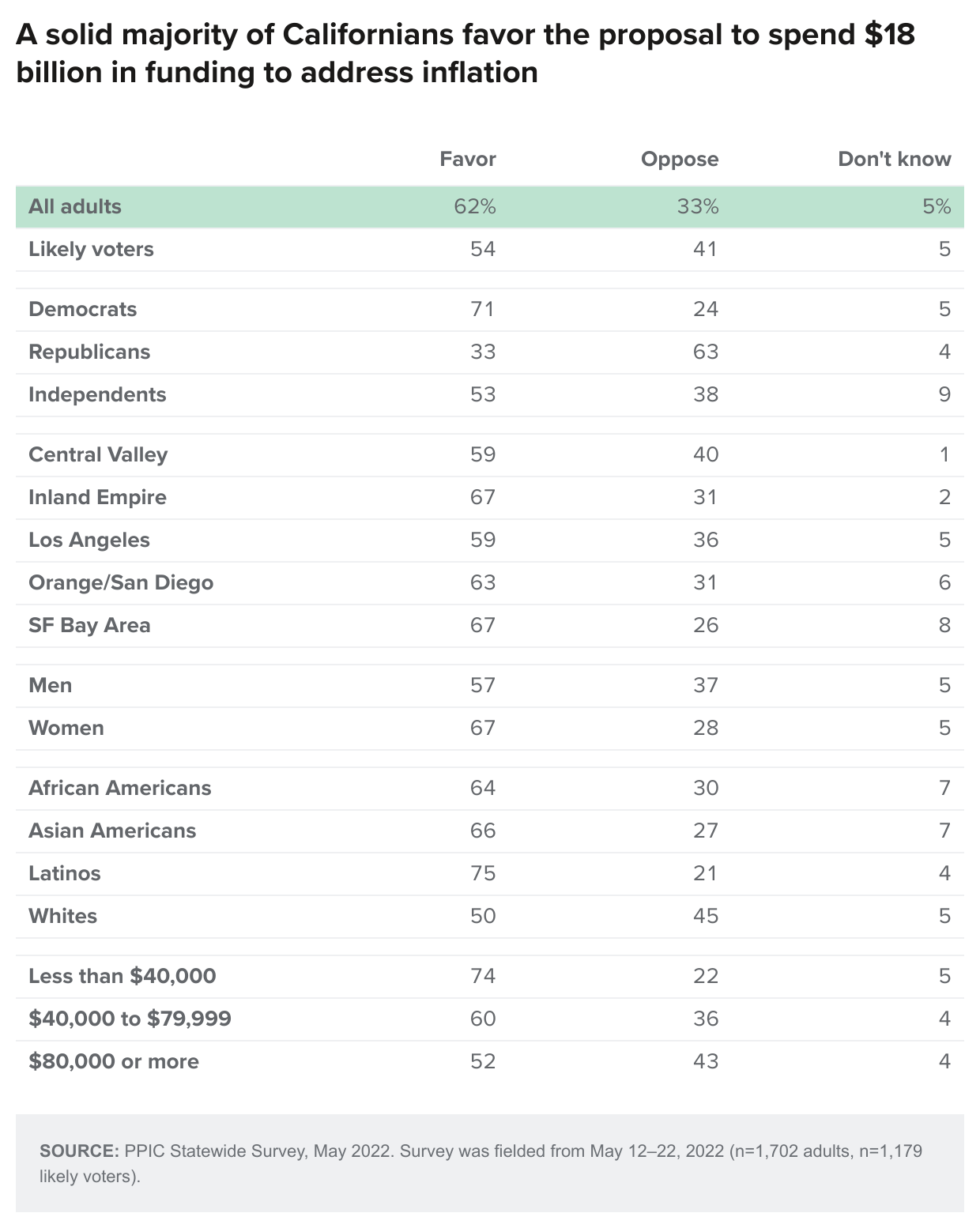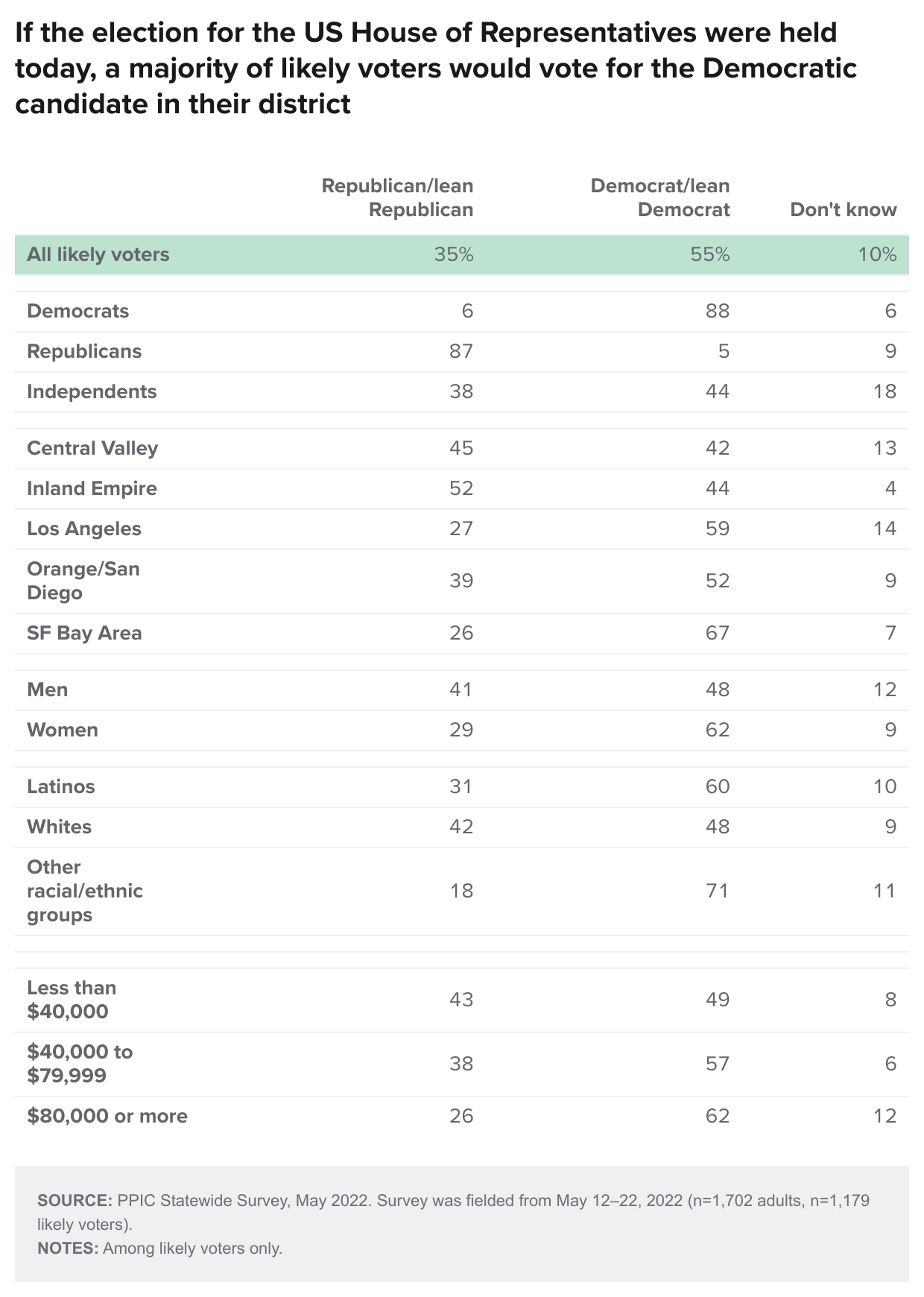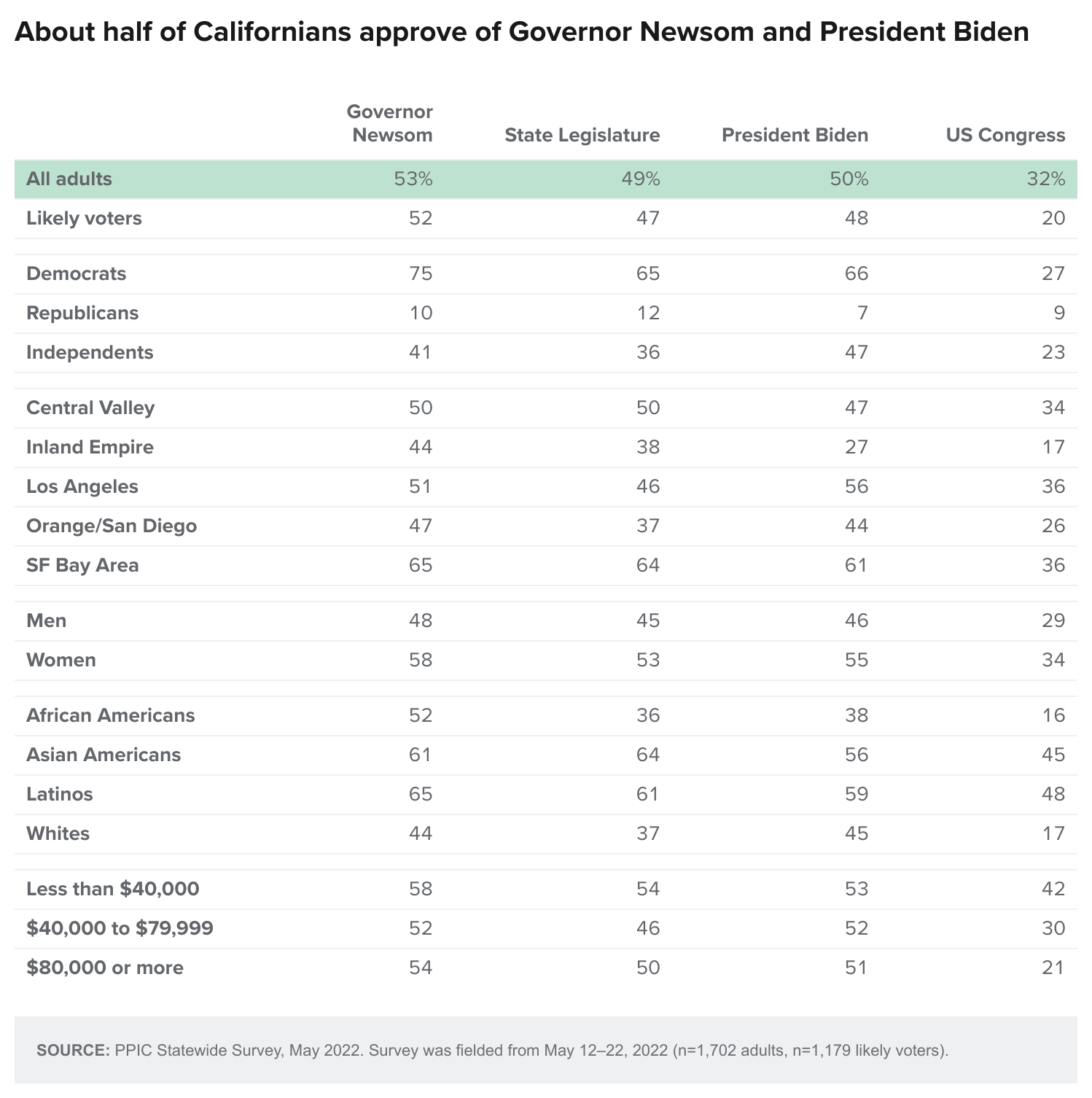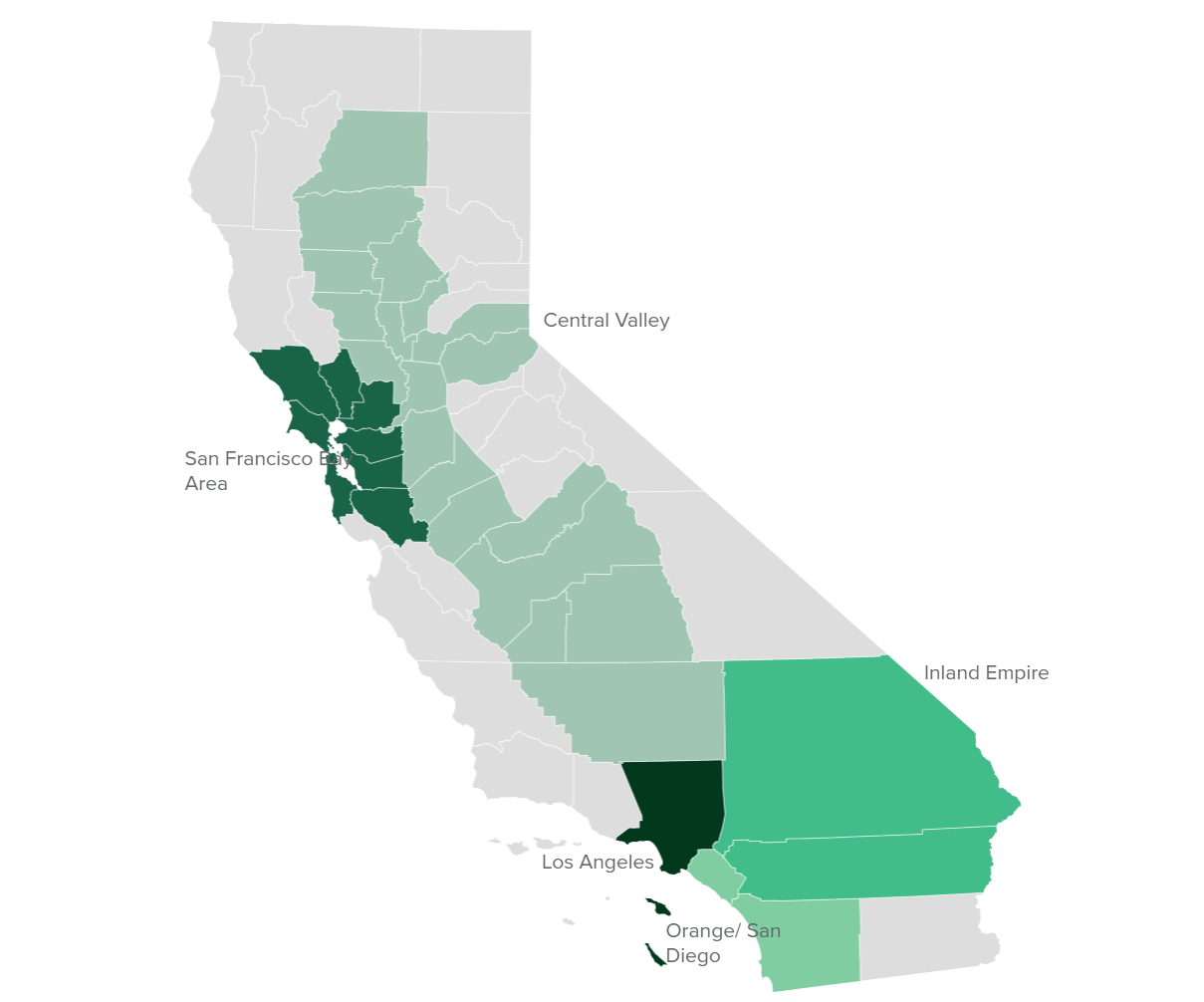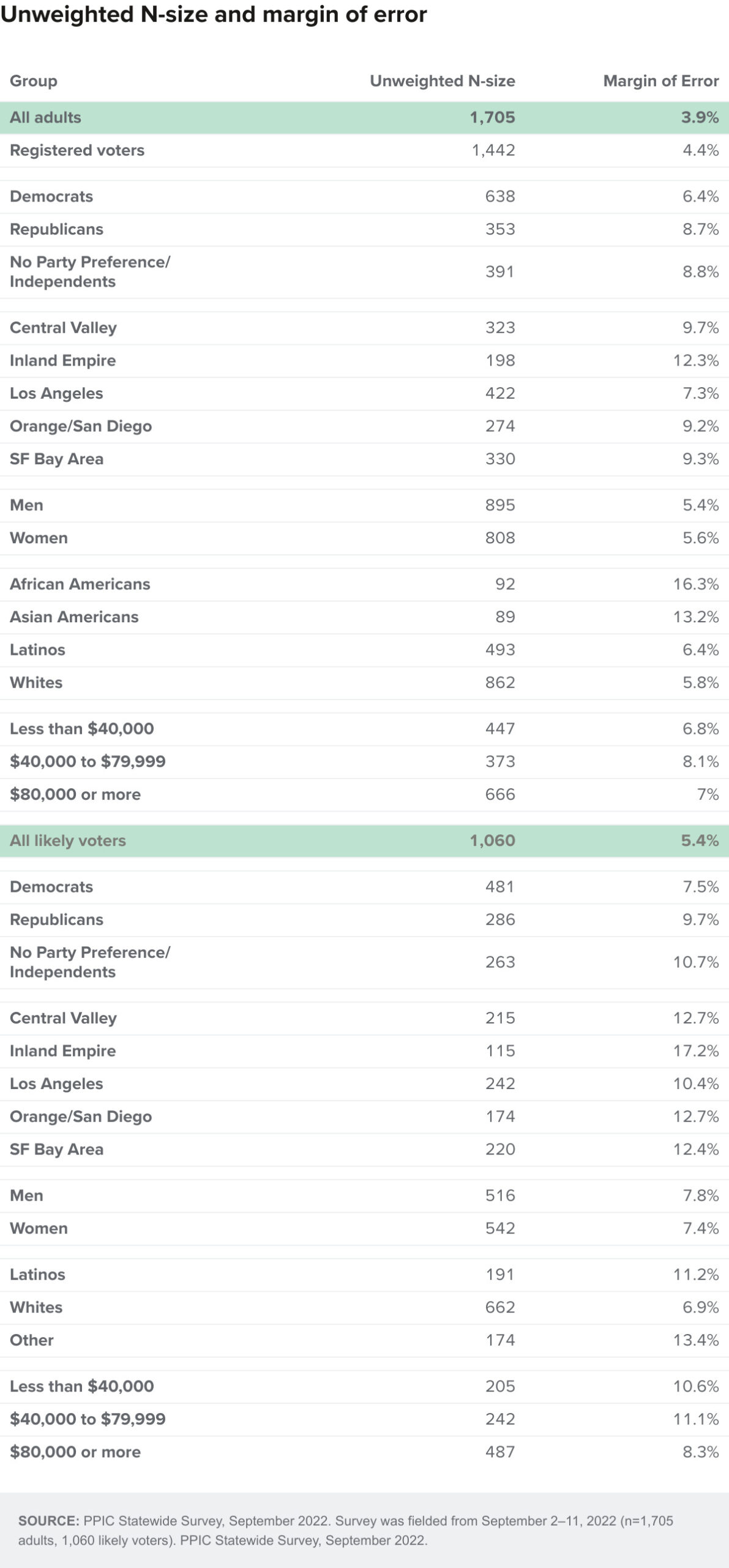Key Findings
Every California voter has received a June 7 primary ballot in the mail and they have been weighing their election choices in the midst of disturbing news and unsettling circumstances. Inflation continues to take a daily toll on consumers and dampens their economic outlook. Russia’s invasion of Ukraine has turned into a deadly and protracted military conflict. The latest omicron variant is resulting in yet another surge in COVID cases. And Californians are being asked to conserve water in response to the drought while bracing themselves for wildfire season. The one bright spot is Governor Newsom’s May revision, which includes a record-setting surplus of revenues available for the state budget.
These are among the key findings of a statewide survey on state and national issues that was conducted from May 12 to 22 by the Public Policy Institute of California:
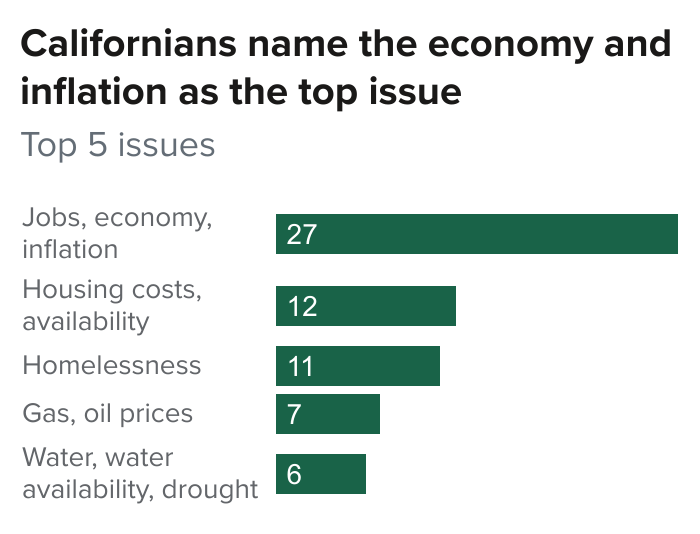 Californians name inflation, jobs, and the economy as the top issue facing the state today. Californians are deeply divided along party lines about whether the state is headed in the right direction. Meanwhile, 30 percent think the US is headed in the right direction and 22 percent expect the US to have good times financially during the next 12 months. →
Californians name inflation, jobs, and the economy as the top issue facing the state today. Californians are deeply divided along party lines about whether the state is headed in the right direction. Meanwhile, 30 percent think the US is headed in the right direction and 22 percent expect the US to have good times financially during the next 12 months. →- More than one in three say that rising prices are causing serious financial hardship for their households. Thirty-seven percent say they are financially worse off today than they were a year ago. For lower-income residents, 53 percent say that rising prices are causing serious financial hardship, and 46 percent say their finances are worse now than they were a year ago. →
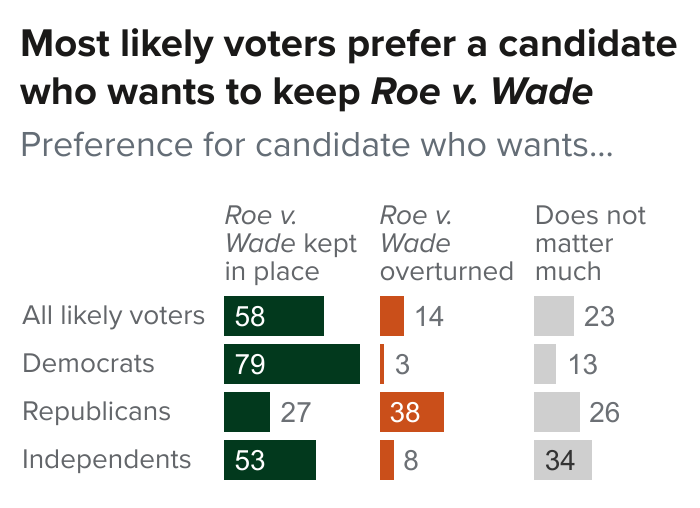 About half of Californians support sanctions on Russia even if they lead to higher energy prices. Slightly less than half approve of how President Biden has handled Russia’s invasion of Ukraine, while a plurality say the US is offering the right amount of support to Ukraine. Seven in ten are in favor of admitting thousands of Ukrainian refugees into the US. →
About half of Californians support sanctions on Russia even if they lead to higher energy prices. Slightly less than half approve of how President Biden has handled Russia’s invasion of Ukraine, while a plurality say the US is offering the right amount of support to Ukraine. Seven in ten are in favor of admitting thousands of Ukrainian refugees into the US. →- Partisans are divided on how to spend the state’s surplus revenues. Democrats prefer to increase funding for education and health and human services, while Republicans prefer to refund some of the money to residents. A solid majority of Californians favor the governor’s proposal to spend $18 billion to address inflation, mostly through vehicle-owner tax rebates and three months of free public transit. →
- Fifty-five percent of California likely voters would support the Democratic candidate in their local US House race. About six in ten likely voters, and eight in ten Democrats, are more likely to support a candidate who wants Roe v. Wade kept in place. Republicans are much more likely than Democrats to say they are extremely or very enthusiastic about voting for Congress this year. →
- About half of Californians continue to approve of Governor Newsom and President Biden. About half approve of the state legislature while one in three approve of the US Congress. Approval ratings of federal and state elected officials vary widely across partisan groups. →
Top Issues and Overall Mood
When asked to name the most important issue facing the state today, one in three Californians mention either jobs, the economy, and inflation (27%) or gasoline prices (7%), while about one in four mention housing costs and availability (12%) or homelessness (11%). Across regions, parties, and demographic groups, Californians name jobs, the economy, and inflation as the top issue.

When it comes to the general direction of the state, more Californians and likely voters say that the state is headed in the wrong direction (50%) than the right direction. The last time we asked this question, in February, half of Californians (50%) were optimistic (45% wrong direction). Today, across regions, about half or more Californians say that the state is headed in the wrong direction, except in the San Francisco Bay Area, where 61 percent say the state is headed in the right direction. There is a wide partisan divide: six in ten Democrats are optimistic (62%) about the direction of the state, while six in ten independents (62%) and nearly nine in ten Republicans (87%) are pessimistic. Men (56%) are more likely than women (44%) to say the state is headed in the wrong direction. Across demographic groups, the share saying the state is headed in the right direction only reaches a majority among Asian Americans (59%) and college graduates (54%).
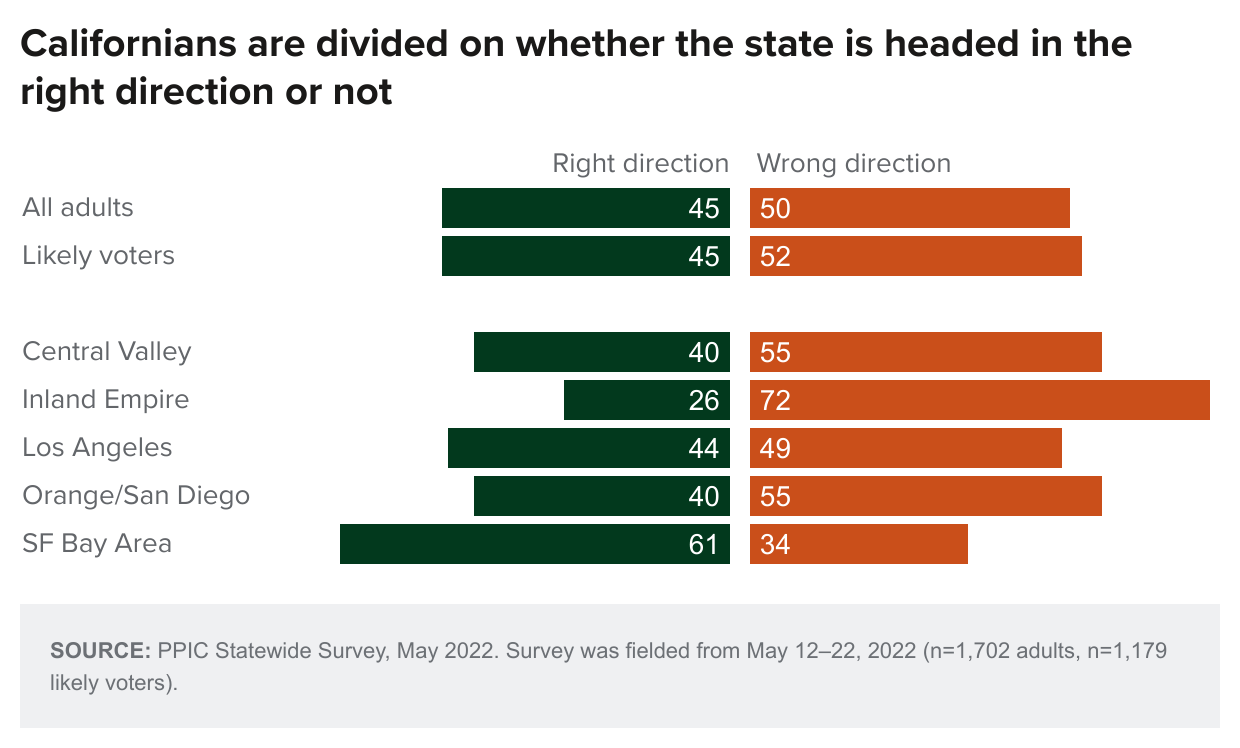
While there are glimmers of optimism regarding the direction of the state, pessimism prevails when it comes to how Californians feel about the nation’s direction and economic outlook. Thirty percent think the US is headed in the right direction and 22 percent expect the US to have good times financially during the next 12 months. About four in ten or fewer across parties, regions, and demographic groups think the nation is headed in the right direction, while one in three or fewer across these groups expect good times for the US in the next 12 months. In February, Californians were more optimistic with 38 percent saying the nation was headed in the right direction and expecting good economic times.
Personal Finances
Two in three Californians say that rising prices are causing hardship for their households, with more than one in three saying they are experiencing serious hardship. In March, findings were similar (35% serious hardship; 32% hardship, but not serious). Today, Republicans (49%) are twice as likely as Democrats (25%) to say they are experiencing serious hardship. Across regions, the share experiencing serious hardship is highest in the Central Valley (48%) and lowest in the San Francisco Bay Area (26%). African Americans are the most likely across racial/ethnic groups to report experiencing serious hardship due to rising prices. Californians with lower incomes are much more likely to report serious hardship than those with higher incomes.
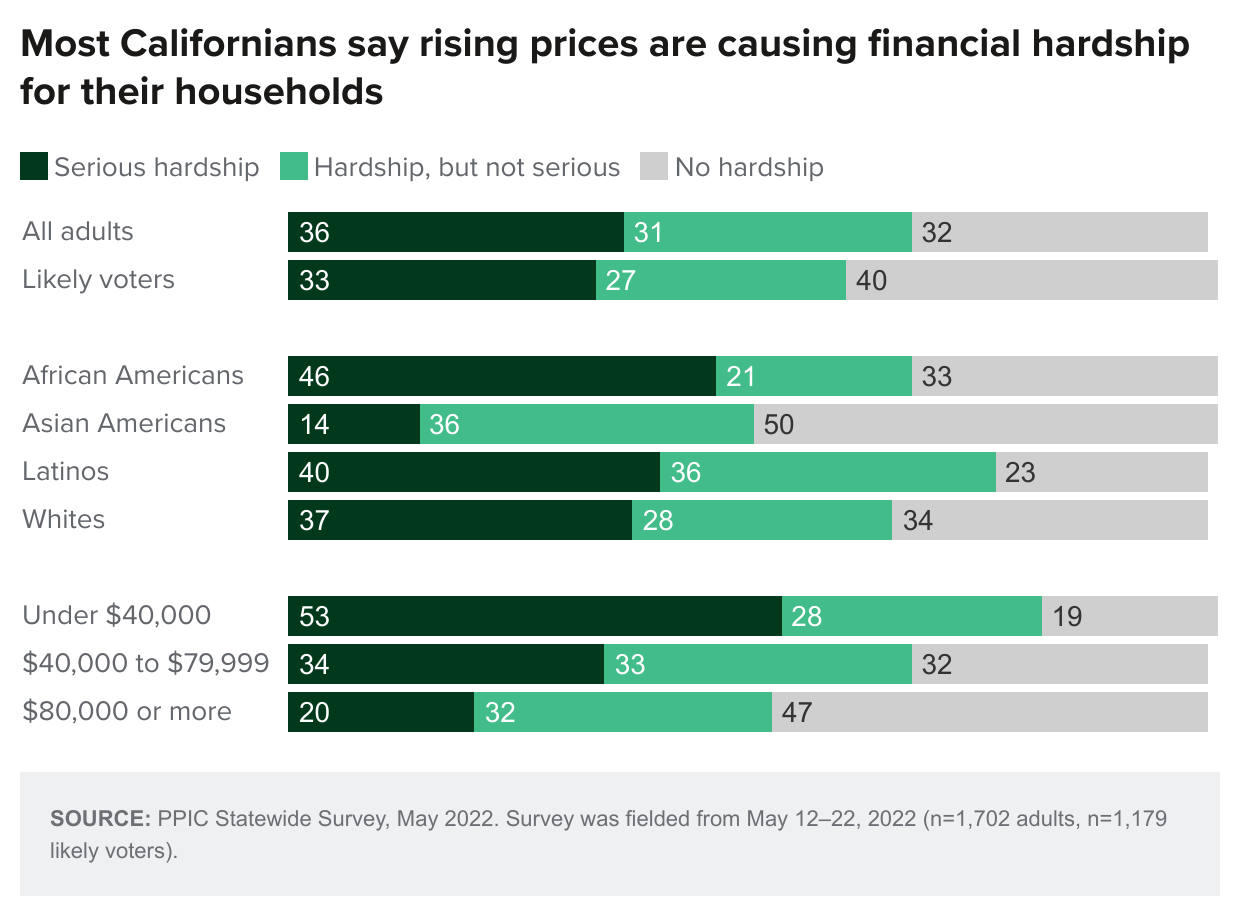
When asked about their personal finances, few Californians (15%) say they are better off than they were a year ago, while nearly half (48%) say their finances are about the same and 37 percent say they are worse off than a year ago. Republicans (60%) are far more likely than independents (39%) and Democrats (25%) to say their finances are worse off. Across regions, the share saying their finances are worse off is highest in the Inland Empire (49%) and lowest in the San Francisco Bay Area (30%) (41% Central Valley, 34% Los Angeles, 34% Orange/San Diego). Whites and Latinos are more likely than African Americans and Asian Americans to say their finances are worse off, and this perception is much higher among lower-income residents.
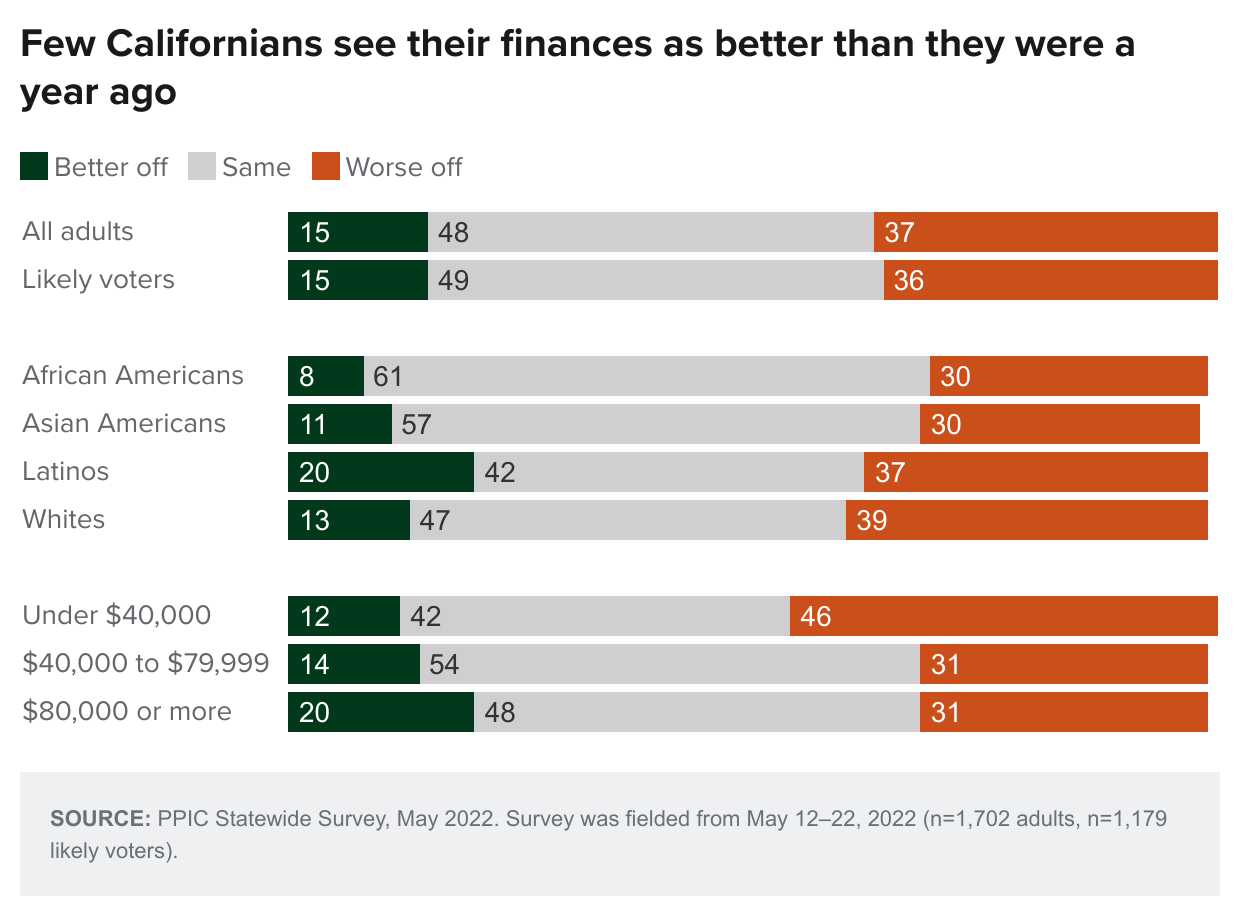
Income inequality has been a persistent issue in California, and today seven in ten Californians believe that the state is divided into haves and have-nots. Since 2011, more than six in ten Californians have held this view in our surveys. Today, the belief that the state is divided into two economic groups is widespread, with two in three or more across parties, regions, and demographic groups holding this view. When asked which group they belong to, Californians are slightly more likely to say they are part of the have-nots (45%) than the haves (39%). Across partisan and demographic groups, Democrats (53%), those with household incomes greater than $80,000 (62%), college graduates (58%), Asian Americans (49%), and whites (48%) are more likely to say they are part of the haves, rather than the have-nots. Sixty-four percent of those with household incomes of less than $40,000 say they are part of the have-nots, rather than the haves.
Russia’s Invasion of Ukraine
Three months after Russia began its invasion of Ukraine, seven in ten Californians support the US and European allies imposing sanctions on Russia, including half who support sanctions, even if they lead to higher energy prices. The share supporting sanctions was slightly higher in March (56% support, even if higher energy prices; 4% support, no opinion if higher energy prices; 16% support, but not if higher energy prices; 19% oppose; 5% don’t know). About half or more across partisan groups support sanctions even if it means higher energy prices, although Democrats are more likely than Republicans or independents to do so. Majorities in Los Angeles (54%) support sanctions even if it means higher energy prices, compared to about half in the San Francisco Bay Area (51%), Orange/San Diego (48%), and the Inland Empire (47%) and fewer in the Central Valley (41%). Support—even if it leads to higher energy prices—increases with rising age, education, and income levels. Across racial/ethnic groups, majorities of whites (66%) and African Americans (53%) are supportive, compared to fewer Asian Americans (43%) and Latinos (36%).

In thinking about Russia’s invasion of Ukraine, 70 percent of California adults and 72 percent of likely voters support the idea of admitting thousands of Ukrainian refugees into the United States. About half or more are in favor, although the level of support varies widely across partisan groups (79% Democrats, 70% independents, 49% Republicans). Across regions and demographic groups, solid majorities are in favor of admitting Ukrainian refugees. Statewide results were similar to findings in a national survey by the Pew Research Center in March (69% favor).
Overall, 47 percent of Californians approve of President Biden’s handling of the situation involving Ukraine and Russia—similar to his overall approval rating. Partisans are sharply divided on this issue, and approval across regions is higher in Los Angeles and the San Francisco Bay Area than in the Central Valley, Inland Empire, and Orange/San Diego. Approval of Biden’s handling of this situation increases with rising income levels and is similar among men and women. Across racial/ethnic groups, a solid majority of Asian Americans (61%) approve of the president’s handling of the invasion, compared to fewer than half in other racial/ethnic groups.
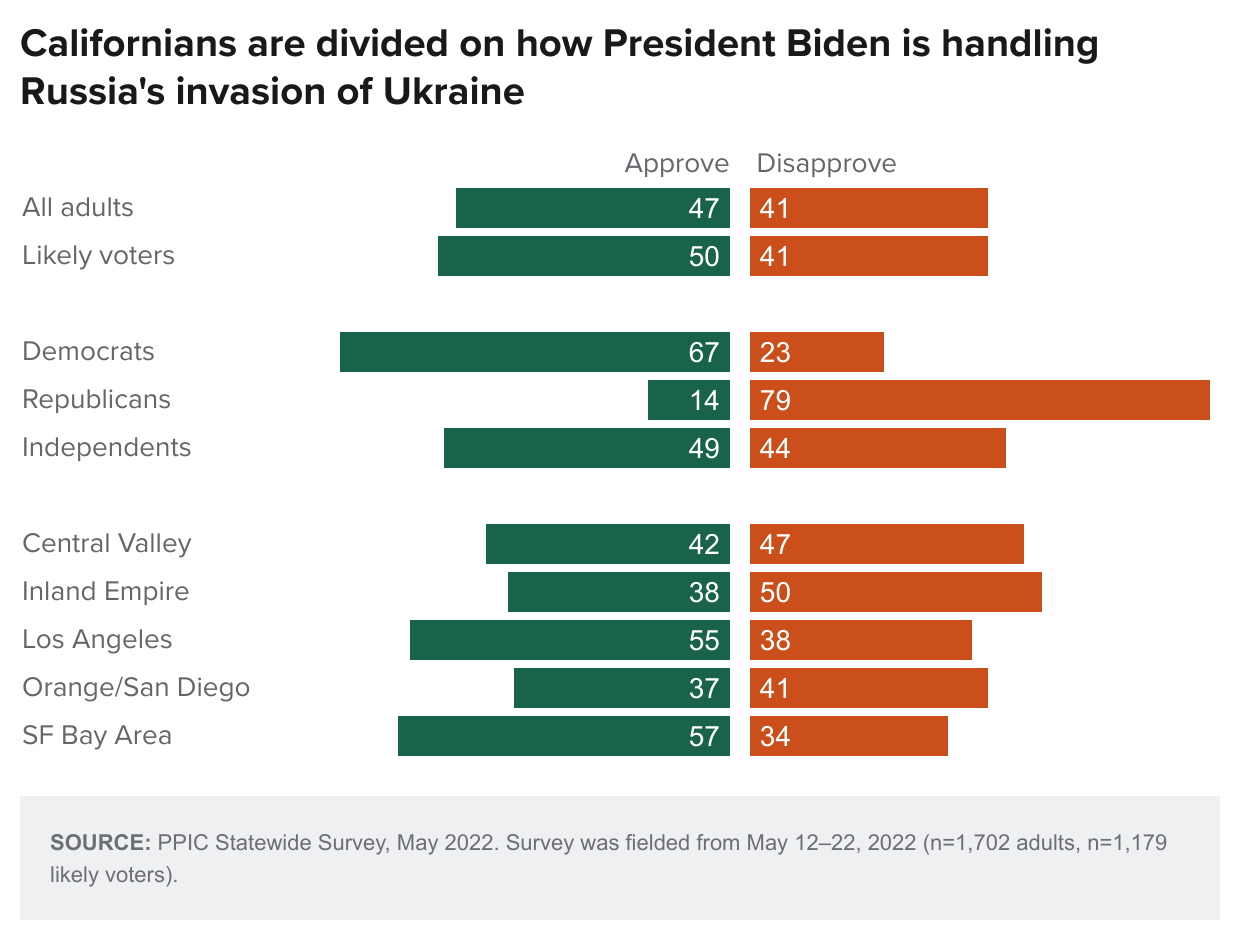
When asked about the level of support the United States is providing to Ukraine to combat Russia’s invasion efforts, a plurality (35%) of Californians say the US is providing about the right amount of support; fewer say not enough support (20%) or too much support (13%), while about one-third are not sure. Among partisans, a plurality of Democrats and independents say the US is providing about the right amount of support, while Republicans are divided. Across demographic groups, pluralities say the US is providing about the right amount of support to Ukraine. Indeed, fewer than two in ten in any group think the US is providing too much support, while fewer than one in four say not enough support. About a quarter or more across demographic groups say they are unsure how to answer the question.
State Budget
Earlier this month, Governor Newsom released a $300.6 billion spending plan and announced an estimated $97.5 billion state budget surplus. A record-low 35 percent of adults (39 percent of likely voters) say the state budget situation is a big problem (somewhat of a problem: 38% adults, 35% likely voters; not a problem: 18% adults, 22% likely voters). Similar shares held this view last May (36%) and the share of adults saying it is a big problem has been declining in recent years. Today, 23 percent of Democrats say the budget situation is a big problem, compared to an overwhelming majority of Republicans (72%) and forty-four percent of independents. Across racial/ethnic groups, African Americans and whites (46% each) are much more likely than Asian Americans (21%) and Latinos (27%) to say it is a big problem. Across regions, Californians in the Central Valley (44%), Orange/San Diego (44%), and the Inland Empire (43%) are the most likely to say the budget is a big problem (32% Los Angeles, 23% San Francisco Bay Area). Similar shares of men (35%) and women (36%) say this, and older adults are more likely to say this than younger adults.
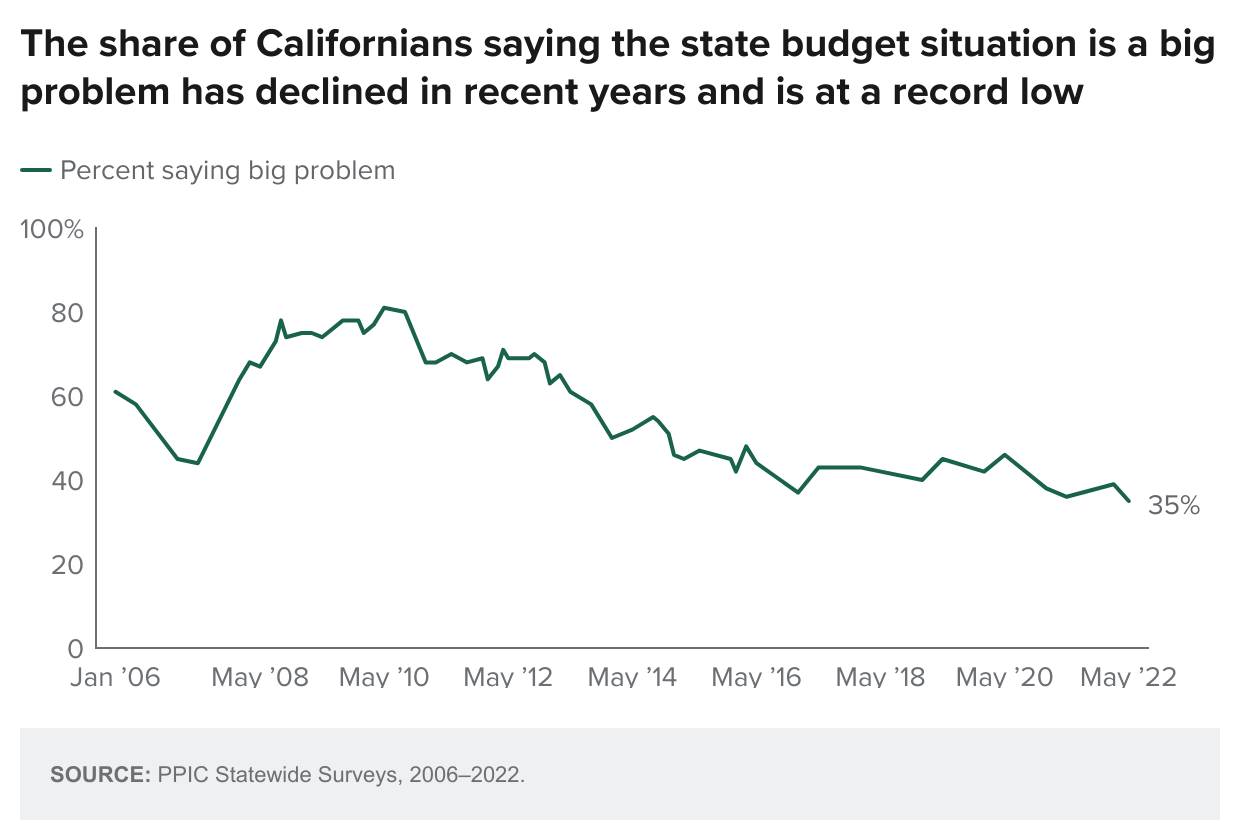
Californians are divided when asked how to use the nearly $100 billion budget surplus. One in three want to increase funding for education and health and human services, while 27 percent want to refund some of the money to the people of California and 22 percent favor one-time state spending for transportation, water, and infrastructure. Just 13 percent want to pay down state debt and build up the reserve. Partisans hold differing views: Democrats are the most likely to favor funding education and health and human services, and Republicans are the most supportive of refunding money to Californians; independents are more divided. Residents in the Inland Empire prefer to refund some of the money, while residents in other regions are more likely to prefer increased funding for education and health and human services. A plurality of Latinos want to increase funding for education and health and human services, while African Americans, Asian Americans, and whites are more divided.

Part of Governor Newsom’s budget plan includes a proposal to spend $18 billion to address inflation, with most of this funding going toward tax rebates for vehicle owners and free public transportation for three months. A majority of adults and likely voters favor this proposal. Partisans offer opposing views, with an overwhelming majority of Democrats and about half of independents in favor, compared to 33 percent of Republicans. Majorities across regions favor the proposal. Half or more across age, education, gender, homeownership, income, and racial/ethnic groups are in favor, but support declines with rising age and income levels.
Midterm Elections
With the June primary just a week and a half away, nearly four in ten likely voters are extremely or very enthusiastic about voting for Congress this year. This level of enthusiasm is much higher among Republicans than among Democrats or independents. The share of Californians saying they are extremely or very enthusiastic is roughly similar across regions, with slightly higher levels of enthusiasm in the Central Valley, the Inland Empire, and Orange/San Diego. Enthusiasm about voting was somewhat similar in May 2018, before the last midterm election.

With a leaked draft opinion from the Supreme Court showing that Roe v. Wade may be on the verge of being overturned, what role will this decision play in upcoming elections? Likely voters—by a four-to-one margin—say they are more likely to support a candidate who wants Roe v. Wade kept in place (58%) than one who wants the landmark decision overturned (14%). About one in five likely voters (23%) say a candidate’s position on this issue does not matter much. There is a wide partisan divide, with eight in ten Democratic likely voters, along with about half of independents, saying they are more likely to support a candidate who wants Roe kept in place, while about four in ten Republicans are more likely to support a candidate who wants Roe overturned. Men (48%) are much less likely than women (66%) to say they would likely prefer a candidate who wants Roe kept in place. Latinos (43%) are much less likely than whites (59%) and members of other racial/ethic groups (70%) to be supportive of a candidate who wants to keep Roe. (Sample sizes for Asian American and African American likely voters are too small for separate analysis.)
Half of likely voters in Republican-held districts are more likely to support a candidate who wants the decision kept in place (50%), while six in ten in Democratic-held districts (60%) hold this view. In the ten competitive California districts as defined by the Cook Political Report, likely voters (59% kept in place, 15% overturned, 19% does not matter much) hold similar opinions to likely voters statewide. The April PPIC Statewide Survey found that 76 percent of likely voters (90% Democrats, 51% Republicans, 76% independents) would not like to see the Supreme Court overturn the Roe v. Wade decision.
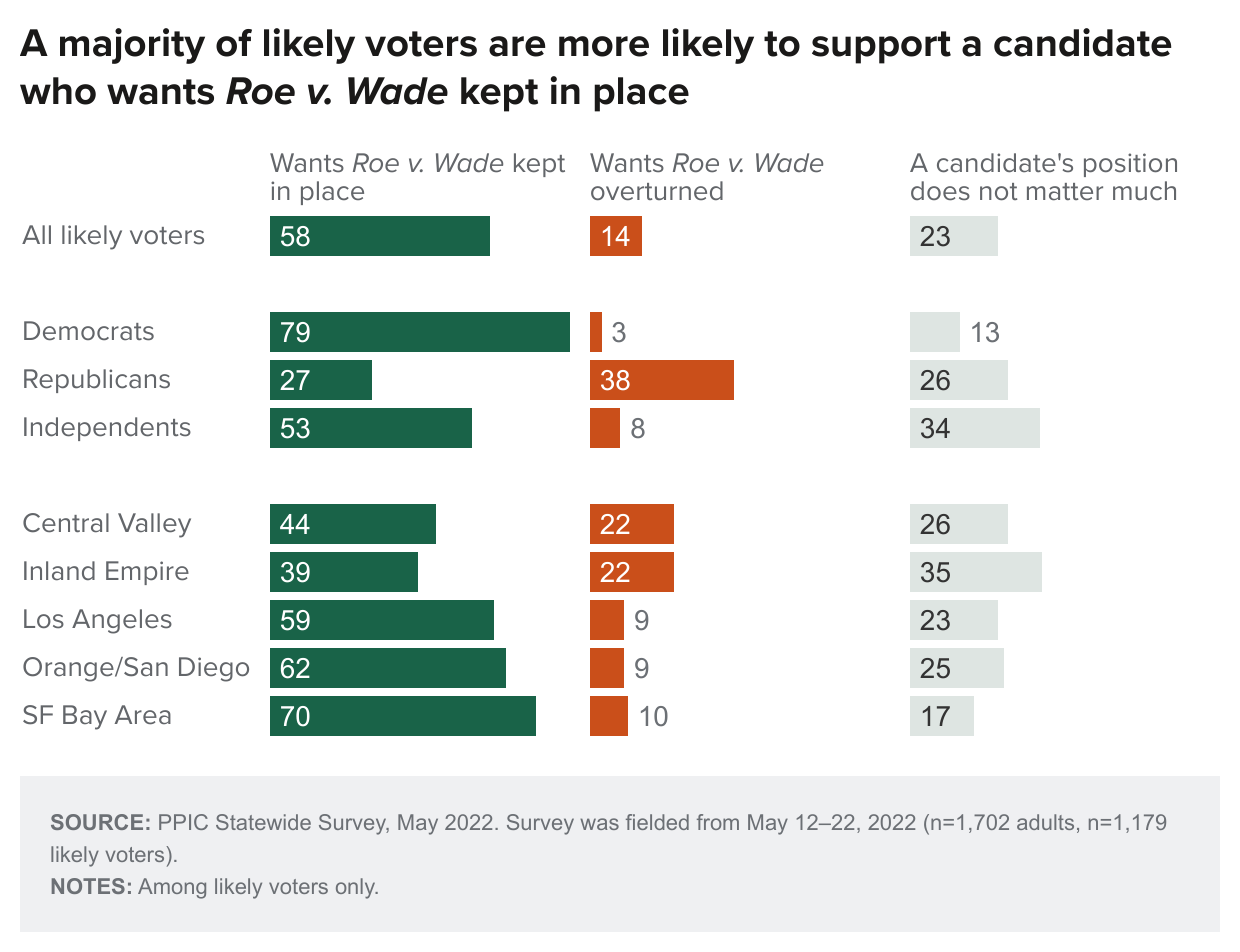
If the 2022 election for the US House of Representatives were held today, 55 percent of likely voters would vote for or lean toward the Democratic candidate, while 35 percent would vote for or lean toward the Republican candidate. An overwhelming majority of partisans support their party’s candidate, while independents are more divided (38% Republican/lean Republican, 44% Democrat/lean Democrat). Democratic candidates are preferred by a 26-point margin (59% to 33%) in Democratic-held districts, while Republican candidates are preferred by a 10-point margin (50% to 40%) in Republican-held districts. In competitive districts, the Democratic candidate is preferred by a 9-point margin (49% to 40%).
Approval Ratings
Roughly five months before the midterm election that could give Governor Newsom a second term, 53% of adults and 52% of likely voters approve of the governor’s job performance. Similar shares held this view one year ago and approval of Governor Newsom among all adults has remained above 50 percent since January 2020. Seventy-five percent of Democrats approve of Newsom, while 82 percent of Republicans disapprove; independents are divided. Approval is highest in the San Francisco Bay Area and lowest in the Inland Empire. The share approving of the governor is higher among women (58%) than men (48%); it is also higher among Latinos (65%), Asian Americans (61%), and African Americans (52%) than whites (44%). Adults with some college education are less likely than those with a high school degree only and college graduates to approve. Approval decreases as age increases.
Forty-nine percent of adults and 47 percent of likely voters approve of the state legislature; views were similar last March. Approval reaches a majority among Democrats, San Francisco Bay Area residents, women, Asian Americans, Latinos, adults with a high school education, college graduates, adults making less than $40,000, and adults age 18 to 34.

About half of Californians (50%) and likely voters (48%) approve of the job Joe Biden is doing as president—much lower than a year ago when 66 percent of adults and 60 percent of likely voters approved. Today, 66 percent of Democrats approve of the president while most Republicans disapprove; independents are divided. Majorities of residents in the San Francisco Bay Area and Los Angeles approve, while majorities of residents in Orange/San Diego and the Inland Empire disapprove; Central Valley residents are divided in their views. The president’s approval rating is higher among women (55%) than men (46%); it is also higher among Latinos (59%) and Asian Americans (56%) than among whites (45%) and African Americans (38%). In a recent NBC News poll, 39 percent of adults nationwide approved of President Biden’s job performance.
In California, 32 percent of adults and 20 percent of likely voters approve of the job Congress is doing. Notably, approval fails to reach 50 percent across parties, regions, and demographic groups. In a March Gallup poll, 21 percent of adults nationwide approved of Congress’s job performance.

Topics
COVID-19 Economy Health & Safety Net Political Landscape Statewide SurveyLearn More

Broad Support among Californians for Admitting Ukrainian Refugees

Budget Surplus Divides Californians
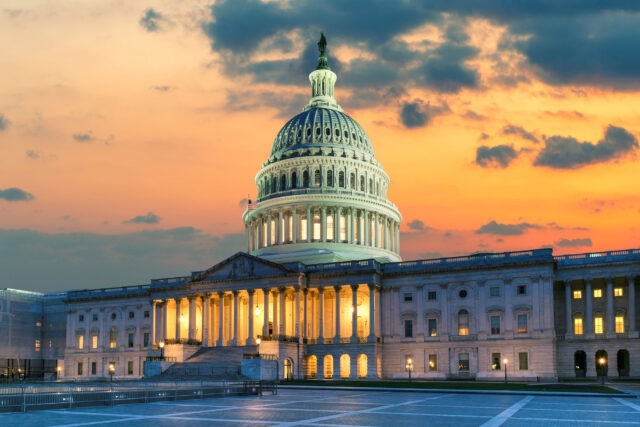
Californians’ Trust in Washington Is Low

Most California Voters Say “We Know Best”

Primary Takeaways and a Preview of the Fall Election
